service interval SKODA SUPERB 2010 2.G / (B6/3T) User Guide
[x] Cancel search | Manufacturer: SKODA, Model Year: 2010, Model line: SUPERB, Model: SKODA SUPERB 2010 2.G / (B6/3T)Pages: 287, PDF Size: 16.59 MB
Page 199 of 287
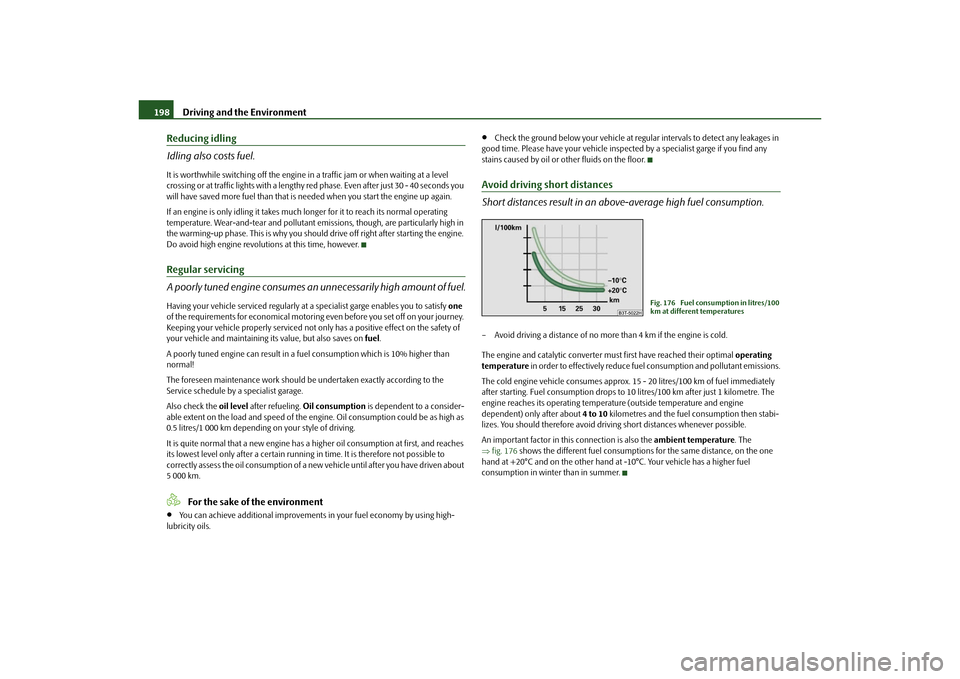
Driving and the Environment
198
Reducing idling
Idling also costs fuel.It is worthwhile switching off the engine in a traffic jam or when waiting at a level
crossing or at traffic lights with a lengthy red phase. Even after just 30 - 40 seconds you
will have saved more fuel th an that is needed when you start the engine up again.
If an engine is only idling it takes much longer for it to reach its normal operating
temperature. Wear-and-tear and pollutant emis sions, though, are particularly high in
the warming-up phase. This is why you should drive off right after starting the engine.
Do avoid high engine revolu tions at this time, however.Regular servicing
A poorly tuned engine consumes an unnecessarily high amount of fuel.Having your vehicle serviced regularly at a specialist garge enables you to satisfy one
of the requirements for economical motoring even before you set off on your journey.
Keeping your vehicle properly serviced not on ly has a positive effect on the safety of
your vehicle and maintaining its value, but also saves on fuel.
A poorly tuned engine can result in a fu el consumption which is 10% higher than
normal!
The foreseen maintenance work should be undertaken exactly according to the
Service schedule by a specialist garage.
Also check the oil level after refueling. Oil consumption is dependent to a consider-
able extent on the load and speed of the en gine. Oil consumption could be as high as
0.5 litres/1 000 km depending on your style of driving.
It is quite normal that a new engine has a higher oil consumption at first, and reaches
its lowest level only after a certain running in time. It is therefore not possible to
correctly assess the oil consumption of a new vehicle until after you have driven about
5 000 km.
For the sake of the environment
You can achieve additional improvements in your fuel economy by using high-
lubricity oils.
Check the ground below your vehicle at regular intervals to detect any leakages in
good time. Please have your vehicle inspec ted by a specialist garge if you find any
stains caused by oil or other fluids on the floor.
Avoid driving short distances
Short distances result in an above-average high fuel consumption.– Avoid driving a distance of no more than 4 km if the engine is cold.
The engine and catalytic converter mu st first have reached their optimal operating
temperature in order to effectively reduce fuel consumption and pollutant emissions.
The cold engine vehicle cons umes approx. 15 - 20 litres/100 km of fuel immediately
after starting. Fuel co nsumption drops to 10 litres/100 km after just 1 kilometre. The
engine reaches its operating temperat ure (outside temperature and engine
dependent) only after about 4 to 10 kilometres and the fuel consumption then stabi-
lizes. You should therefore avoid driving short distances whenever possible.
An important factor in this connection is also the ambient temperature. The
fig. 176 shows the different fuel consumptions for the same distance, on the one
hand at +20°C and on the other hand at -10°C. Your vehicle has a higher fuel
consumption in winter than in summer.
Fig. 176 Fuel consumption in litres/100
km at different temperatures
s3fg.2.book Page 198 Friday, April 30, 2010 12:17 PM
Page 210 of 287
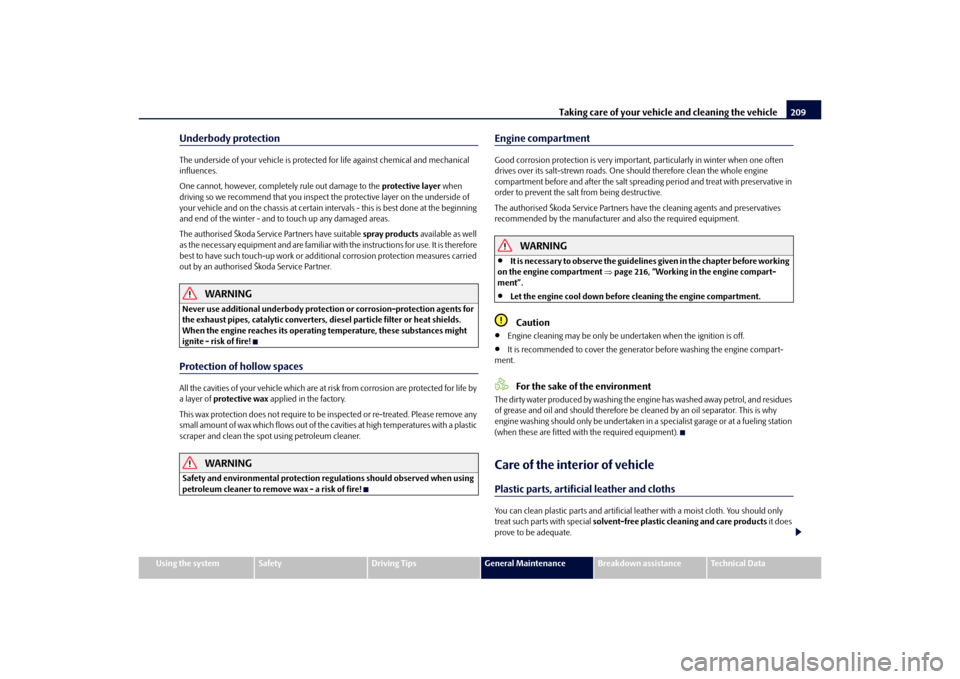
Taking care of your vehicle and cleaning the vehicle209
Using the system
Safety
Driving Tips
General Maintenance
Breakdown assistance
Technical Data
Underbody protectionThe underside of your vehicle is protected for life against chemical and mechanical
influences.
One cannot, however, completely rule out damage to the protective layer when
driving so we recommend that you inspect the protective layer on the underside of
your vehicle and on the chassis at certain intervals - this is best done at the beginning
and end of the winter - and to touch up any damaged areas.
The authorised Škoda Service Partners have suitable spray products available as well
as the necessary equipment and are familiar with the instructions for use. It is therefore
best to have such touch-up work or additional corrosion protection measures carried
out by an authorised Škoda Service Partner.
WARNING
Never use additional underbody protection or corrosion-protection agents for
the exhaust pipes, catalytic converters, di esel particle filter or heat shields.
When the engine reaches its operating temperature, these substances might
ignite - risk of fire!Protection of hollow spacesAll the cavities of your vehicle which are at risk from corrosion are protected for life by
a layer of protective wax applied in the factory.
This wax protection does not require to be inspected or re-treated. Please remove any
small amount of wax which flows out of the cavities at high temperatures with a plastic
scraper and clean the spot using petroleum cleaner.
WARNING
Safety and environmental pr otection regulations should observed when using
petroleum cleaner to remove wax - a risk of fire!
Engine compartmentGood corrosion protection is very importan t, particularly in winter when one often
drives over its salt-strewn roads. One should therefore clean the whole engine
compartment before and after the salt spreading period and treat with preservative in
order to prevent the salt from being destructive.
The authorised Škoda Service Partners have the cleaning agents and preservatives
recommended by the manufacturer and also the required equipment.
WARNING
It is necessary to observ e the guidelines given in the chapter before working
on the engine compartment page 216, “Working in the engine compart-
ment”.
Let the engine cool down before cleaning the engine compartment.Caution
Engine cleaning may be only be un dertaken when the ignition is off.
It is recommended to cover the generator before washing the engine compart-
ment.For the sake of the environment
The dirty water produced by washing the engine has washed away petrol, and residues
of grease and oil and should therefore be cleaned by an oil separator. This is why
engine washing should only be undertaken in a specialist garage or at a fueling station
(when these are fitted with the required equipment).Care of the interior of vehiclePlastic parts, artificial leather and clothsYou can clean plastic parts and artificial leather with a moist cloth. You should only
treat such parts with special solvent-free plastic cleaning and care products it does
prove to be adequate.
s3fg.2.book Page 209 Friday, April 30, 2010 12:17 PM
Page 219 of 287
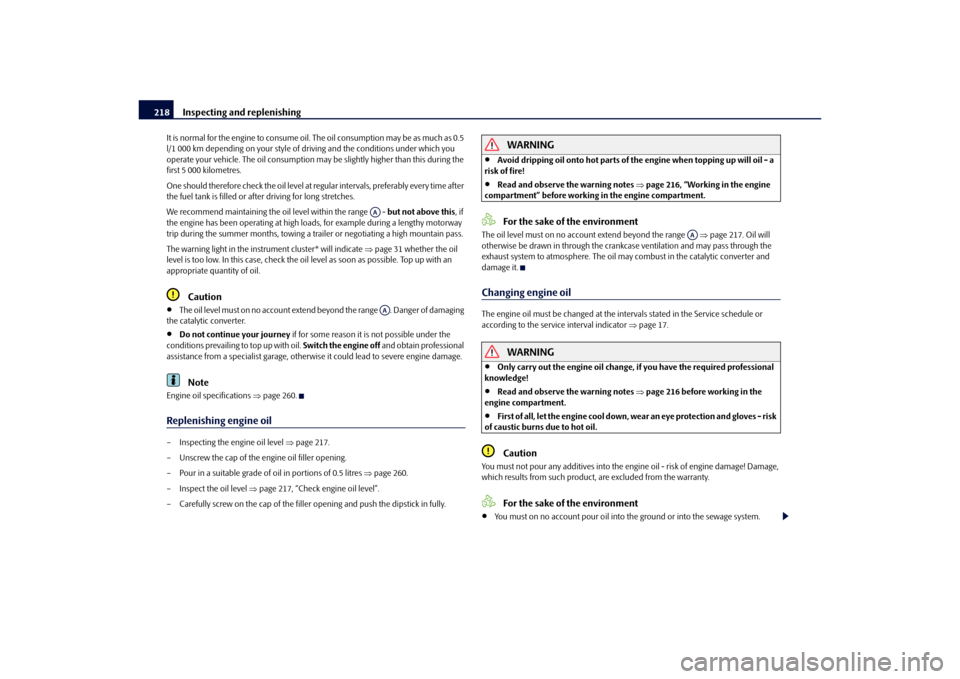
Inspecting and replenishing
218
It is normal for the engine to consume oil. The oil consumption may be as much as 0.5
l/1 000 km depending on your style of driving and the conditions under which you
operate your vehicle. The oil consumption may be slightly hi gher than this during the
first 5 000 kilometres.
One should therefore check the oil level at regular intervals, preferably every time after
the fuel tank is filled or after driving for long stretches.
We recommend maintaining the oil level within the range - but not above this, if
the engine has been operating at high load s, for example during a lengthy motorway
trip during the summer months, towing a tr ailer or negotiating a high mountain pass.
The warning light in the instrument cluster* will indicate page 31 whether the oil
level is too low. In this case, check the oil level as soon as possible. Top up with an
appropriate quantity of oil.
Caution
The oil level must on no account extend beyond the range . Danger of damaging
the catalytic converter.
Do not continue your journey if for some reason it is not possible under the
conditions prevailing to top up with oil. Switch the engine off and obtain professional
assistance from a specialist garage, otherwise it could lead to severe engine damage.Note
Engine oil specifications page 260.Replenishing engine oil– Inspecting the engine oil level page 217.
– Unscrew the cap of the engine oil filler opening.
– Pour in a suitable grade of oil in portions of 0.5 litres page 260.
– Inspect the oil level page 217, “Check engine oil level”.
– Carefully screw on the cap of the filler opening and push the dipstick in fully.
WARNING
Avoid dripping oil onto hot parts of the engine when topping up will oil - a
risk of fire!
Read and observe the warning notes page 216, “Working in the engine
compartment” before working in the engine compartment.For the sake of the environment
The oil level must on no acco unt extend beyond the range page 217. Oil will
otherwise be drawn in through the crankc ase ventilation and may pass through the
exhaust system to atmosphere. The oil ma y combust in the catalytic converter and
damage it.Changing engine oilThe engine oil must be changed at the intervals stated in the Service schedule or
according to the service interval indicator page 17.
WARNING
Only carry out the engine oil change, if you have the required professional
knowledge!
Read and observe the warning notes page 216 before working in the
engine compartment.
First of all, let the engine cool down, we ar an eye protection and gloves - risk
of caustic burns due to hot oil.Caution
You must not pour any additives into the engine oil - risk of engine damage! Damage,
which results from such product, are excluded from the warranty.
For the sake of the environment
You must on no account pour oil into the ground or into the sewage system.
AAAA
AA
s3fg.2.book Page 218 Friday, April 30, 2010 12:17 PM
Page 261 of 287
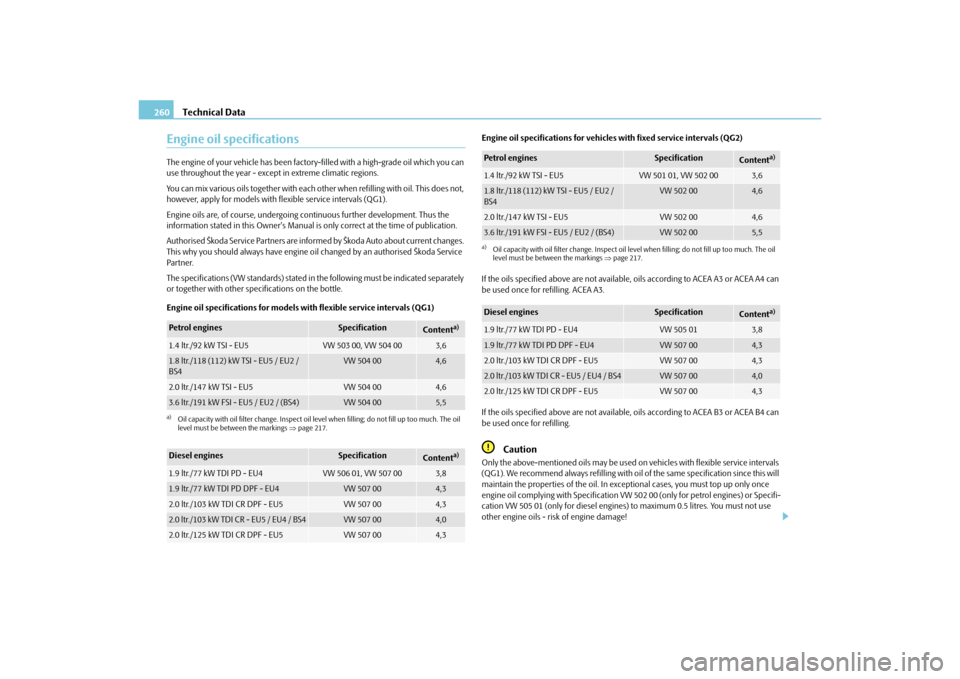
Technical Data
260
Engine oil specificationsThe engine of your vehicle has been factory-filled with a high-grade oil which you can
use throughout the year - except in extreme climatic regions.
You can mix various oils together with each other when refilling with oil. This does not,
however, apply for models with flexible service intervals (QG1).
Engine oils are, of course, undergoing co ntinuous further development. Thus the
information stated in this Owner's Manual is only correct at the time of publication.
Authorised Škoda Service Partners are inform ed by Škoda Auto about current changes.
This why you should always have engine oi l changed by an authorised Škoda Service
Par tner.
The specifications (VW standards) stated in the following must be indicated separately
or together with other specifications on the bottle.
Engine oil specifications for models with flexible service intervals (QG1) Engine oil specifications for vehicles with fixed service intervals (QG2)
If the oils specified above are not available, oils according to ACEA A3 or ACEA A4 can
be used once for refilling. ACEA A3.
If the oils specified above are not available,
oils according to ACEA B3 or ACEA B4 can
be used once for refilling.
Caution
Only the above-mentioned oils may be used on vehicles with flexible service intervals
(QG1). We recommend always refilling with oi l of the same specification since this will
maintain the properties of the oil. In exce ptional cases, you must top up only once
engine oil complying with Specification VW 50 2 00 (only for petrol engines) or Specifi-
cation VW 505 01 (only for diesel engines) to maximum 0.5 litres. You must not use
other engine oils - risk of engine damage!
Petrol engines
Specification
Content
a)
a)Oil capacity with oil filter change. Inspect oil leve l when filling; do not fill up too much. The oil
level must be between the markings page 217.1.4 ltr./92 kW TSI - EU5
VW 503 00, VW 504 00
3,6
1.8 ltr./118 (112) kW TSI - EU5 / EU2 /
BS4
VW 504 00
4,6
2.0 ltr./147 kW TSI - EU5
VW 504 00
4,6
3.6 ltr./191 kW FSI - EU5 / EU2 / (BS4)
VW 504 00
5,5
Diesel engines
Specification
Content
a)
1.9 ltr./77 kW TDI PD - EU4
VW 506 01, VW 507 00
3,8
1.9 ltr./77 kW TDI PD DPF - EU4
VW 507 00
4,3
2.0 ltr./103 kW TDI CR DPF - EU5
VW 507 00
4,3
2.0 ltr./103 kW TDI CR - EU5 / EU4 / BS4
VW 507 00
4,0
2.0 ltr./125 kW TDI CR DPF - EU5
VW 507 00
4,3
Petrol engines
Specification
Content
a)
a)Oil capacity with oil filter change. Inspect oil le vel when filling; do not fill up too much. The oil
level must be between the markings page 217.1.4 ltr./92 kW TSI - EU5
VW 501 01, VW 502 00
3,6
1.8 ltr./118 (112) kW TSI - EU5 / EU2 /
BS4
VW 502 00
4,6
2.0 ltr./147 kW TSI - EU5
VW 502 00
4,6
3.6 ltr./191 kW FSI - EU5 / EU2 / (BS4)
VW 502 00
5,5
Diesel engines
Specification
Content
a)
1.9 ltr./77 kW TDI PD - EU4
VW 505 01
3,8
1.9 ltr./77 kW TDI PD DPF - EU4
VW 507 00
4,3
2.0 ltr./103 kW TDI CR DPF - EU5
VW 507 00
4,3
2.0 ltr./103 kW TDI CR - EU5 / EU4 / BS4
VW 507 00
4,0
2.0 ltr./125 kW TDI CR DPF - EU5
VW 507 00
4,3
s3fg.2.book Page 260 Friday, April 30, 2010 12:17 PM
Page 282 of 287
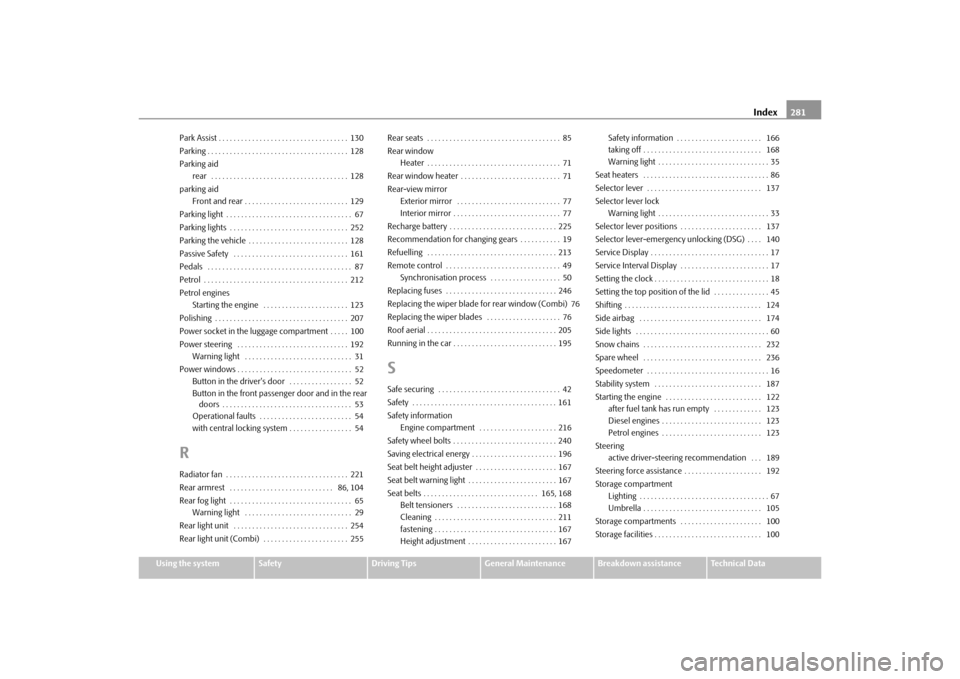
Index281
Using the system
Safety
Driving Tips
General Maintenance
Breakdown assistance
Technical Data
Park Assist . . . . . . . . . . . . . . . . . . . . . . . . . . . . . . . . . . . 130
Parking . . . . . . . . . . . . . . . . . . . . . . . . . . . . . . . . . . . . . . 128
Parking aid
rear . . . . . . . . . . . . . . . . . . . . . . . . . . . . . . . . . . . . . 128
parking aid Front and rear . . . . . . . . . . . . . . . . . . . . . . . . . . . . 129
Parking light . . . . . . . . . . . . . . . . . . . . . . . . . . . . . . . . . . 67
Parking lights . . . . . . . . . . . . . . . . . . . . . . . . . . . . . . . . 252
Parking the vehicle . . . . . . . . . . . . . . . . . . . . . . . . . . . 128
Passive Safety . . . . . . . . . . . . . . . . . . . . . . . . . . . . . . . 161
Pedals . . . . . . . . . . . . . . . . . . . . . . . . . . . . . . . . . . . . . . . 87
Petrol . . . . . . . . . . . . . . . . . . . . . . . . . . . . . . . . . . . . . . . 212
Petrol engines Starting the engine . . . . . . . . . . . . . . . . . . . . . . . 123
Polishing . . . . . . . . . . . . . . . . . . . . . . . . . . . . . . . . . . . . 207
Power socket in the luggage compartment . . . . . 100
Power steering . . . . . . . . . . . . . . . . . . . . . . . . . . . . . . 192 Warning light . . . . . . . . . . . . . . . . . . . . . . . . . . . . . 31
Power windows . . . . . . . . . . . . . . . . . . . . . . . . . . . . . . . 52 Button in the driver's door . . . . . . . . . . . . . . . . . 52
Button in the front passenger door and in the rear doors . . . . . . . . . . . . . . . . . . . . . . . . . . . . . . . . . . . 53
Operational faults . . . . . . . . . . . . . . . . . . . . . . . . . 54
with central locking system . . . . . . . . . . . . . . . . . 54
RRadiator fan . . . . . . . . . . . . . . . . . . . . . . . . . . . . . . . . . 221
Rear armrest . . . . . . . . . . . . . . . . . . . . . . . . . . . . 86, 104
Rear fog light . . . . . . . . . . . . . . . . . . . . . . . . . . . . . . . . . 65 Warning light . . . . . . . . . . . . . . . . . . . . . . . . . . . . . 29
Rear light unit . . . . . . . . . . . . . . . . . . . . . . . . . . . . . . . 254
Rear light unit (Combi) . . . . . . . . . . . . . . . . . . . . . . . 255 Rear seats . . . . . . . . . . . . . . . . . . . . . . . . . . . . . . . . . . . . 85
Rear window
Heater . . . . . . . . . . . . . . . . . . . . . . . . . . . . . . . . . . . . 71
Rear window heater . . . . . . . . . . . . . . . . . . . . . . . . . . . 71
Rear-view mirror Exterior mirror . . . . . . . . . . . . . . . . . . . . . . . . . . . . 77
Interior mirror . . . . . . . . . . . . . . . . . . . . . . . . . . . . . 77
Recharge battery . . . . . . . . . . . . . . . . . . . . . . . . . . . . . 225
Recommendation for changing gears . . . . . . . . . . . 19
Refuelling . . . . . . . . . . . . . . . . . . . . . . . . . . . . . . . . . . . 213
Remote control . . . . . . . . . . . . . . . . . . . . . . . . . . . . . . . 49 Synchronisation process . . . . . . . . . . . . . . . . . . . 50
Replacing fuses . . . . . . . . . . . . . . . . . . . . . . . . . . . . . . 246
Replacing the wiper blade fo r rear window (Combi) 76
Replacing the wiper blades . . . . . . . . . . . . . . . . . . . . 76
Roof aerial . . . . . . . . . . . . . . . . . . . . . . . . . . . . . . . . . . . 205
Running in the car . . . . . . . . . . . . . . . . . . . . . . . . . . . . 195
SSafe securing . . . . . . . . . . . . . . . . . . . . . . . . . . . . . . . . . 42
Safety . . . . . . . . . . . . . . . . . . . . . . . . . . . . . . . . . . . . . . . 161
Safety information Engine compartment . . . . . . . . . . . . . . . . . . . . . 216
Safety wheel bolts . . . . . . . . . . . . . . . . . . . . . . . . . . . . 240
Saving electrical energy . . . . . . . . . . . . . . . . . . . . . . . 196
Seat belt height adjuster . . . . . . . . . . . . . . . . . . . . . . 167
Seat belt warning light . . . . . . . . . . . . . . . . . . . . . . . . 167
Seat belts . . . . . . . . . . . . . . . . . . . . . . . . . . . . . . . 165, 168 Belt tensioners . . . . . . . . . . . . . . . . . . . . . . . . . . . 168
Cleaning . . . . . . . . . . . . . . . . . . . . . . . . . . . . . . . . . 211
fastening . . . . . . . . . . . . . . . . . . . . . . . . . . . . . . . . . 167
Height adjustment . . . . . . . . . . . . . . . . . . . . . . . . 167 Safety information . . . . . . . . . . . . . . . . . . . . . . . 166
taking off . . . . . . . . . . . . . . . . . . . . . . . . . . . . . . . . 168
Warning light . . . . . . . . . . . . . . . . . . . . . . . . . . . . . . 35
Seat heaters . . . . . . . . . . . . . . . . . . . . . . . . . . . . . . . . . . 86
Selector lever . . . . . . . . . . . . . . . . . . . . . . . . . . . . . . . 137
Selector lever lock Warning light . . . . . . . . . . . . . . . . . . . . . . . . . . . . . . 33
Selector lever positions . . . . . . . . . . . . . . . . . . . . . . 137
Selector lever-emergency unl ocking (DSG) . . . . 140
Service Display . . . . . . . . . . . . . . . . . . . . . . . . . . . . . . . . 17
Service Interval Display . . . . . . . . . . . . . . . . . . . . . . . . 17
Setting the clock . . . . . . . . . . . . . . . . . . . . . . . . . . . . . . . 18
Setting the top position of the lid . . . . . . . . . . . . . . . 45
Shifting . . . . . . . . . . . . . . . . . . . . . . . . . . . . . . . . . . . . . 124
Side airbag . . . . . . . . . . . . . . . . . . . . . . . . . . . . . . . . . 174
Side lights . . . . . . . . . . . . . . . . . . . . . . . . . . . . . . . . . . . . 60
Snow chains . . . . . . . . . . . . . . . . . . . . . . . . . . . . . . . . 232
Spare wheel . . . . . . . . . . . . . . . . . . . . . . . . . . . . . . . . 236
Speedometer . . . . . . . . . . . . . . . . . . . . . . . . . . . . . . . . . 16
Stability system . . . . . . . . . . . . . . . . . . . . . . . . . . . . . 187
Starting the engine . . . . . . . . . . . . . . . . . . . . . . . . . . 122 after fuel tank has run empty . . . . . . . . . . . . . 123
Diesel engines . . . . . . . . . . . . . . . . . . . . . . . . . . . 123
Petrol engines . . . . . . . . . . . . . . . . . . . . . . . . . . . 123
Steering active driver-steering recommendation . . . 189
Steering force assistance . . . . . . . . . . . . . . . . . . . . . 192
Storage compartment Lighting . . . . . . . . . . . . . . . . . . . . . . . . . . . . . . . . . . . 67
Umbrella . . . . . . . . . . . . . . . . . . . . . . . . . . . . . . . . 105
Storage compartments . . . . . . . . . . . . . . . . . . . . . . 100
Storage facilities . . . . . . . . . . . . . . . . . . . . . . . . . . . . . 100
s3fg.2.book Page 281 Friday, April 30, 2010 12:17 PM